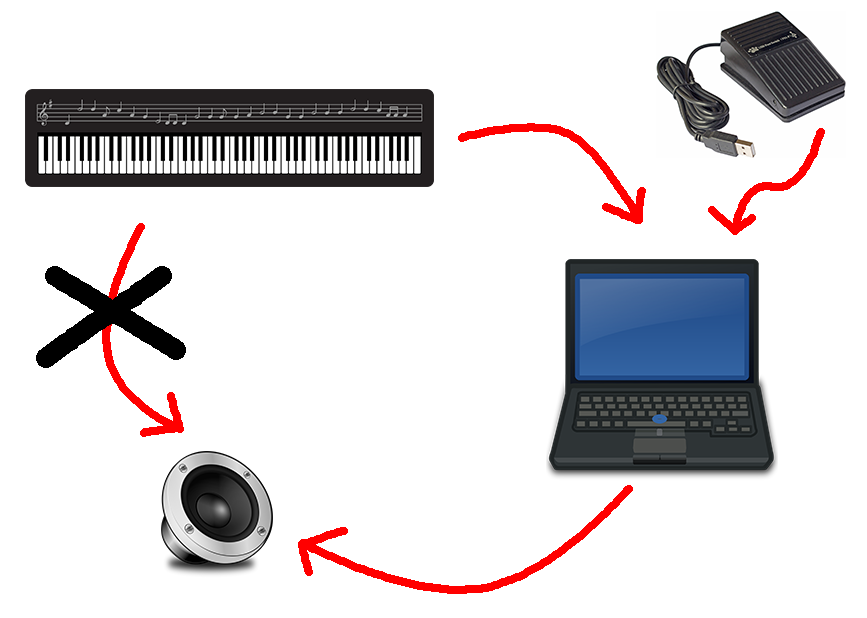In a previous post and video, I dealt with how an independent sostenuto pedal—that is, a sostenuto pedal that works even when the damper pedal is depressed—can be used to expand the possibilities of pedaling technique. I recently posted a video that gets much more specific, focusing on how the independent sostenuto can be used to pedal rolled chords.
I covered the technique involved in my previous post (under the heading “Only Hands Small”). In cases where the notes of the rolled chord cannot be held simultaneously, the sostenuto pedal can catch one or more notes (usually the bass notes). The damper pedal can thus be used with much more flexibility, since it’s no longer required at the beginning of the roll to sustain the full chord.
In the video, I use this example from the Nocturne in C minor, Op. 48, No. 1 by Frédéric Chopin:
By catching the bass notes of the arpeggiated chords on the sostenuto pedal, it becomes possible to change the damper pedal at the end of each roll, keeping a legato line in the treble voice.
Gabriela Montero’s splendid performance of this Nocturne is a good example of how the treble voice can end up with gaps due to pedaling, without the assistance of the sostenuto. Here is my demonstration of how to use overlapping pedal in the passage.
I should mention that there is another common pedaling technique to get a legato melody line without using the sostenuto pedal at all. By holding the melody notes over the pedal changes, it’s possible to avoid gaps in the melody.
The melody will be slightly blurred, because consecutive notes will overlap on a single pedal, but it is so subtle that it is unlikely to be a problem. The passage from the Nocturne is particularly amenable to this technique, because the overlapping melody notes usually fit with the following chords. Lugansky’s performance of this Nocturne is a stellar example of how this can work. However, it can be more difficult with small hands, because the speed of the roll and the quiet dynamic require the chords to be played legato with stretching.
Compared with holding melody notes, the main advantage of overlapping pedals is legato transitions between the full chords, not only between the top melody notes. Actually, the two techniques are closely related; both involve sustaining notes over pedal changes. This is an important technique for advanced pianists and one that is greatly enhanced by the independent sostenuto pedal. Holding the bass notes of rolled chords is just the tip of the iceberg.
Symphonic Etudes
In my video, I demonstrate how the opening rolls of the Symphonic Etudes, Op. 13, by Robert Schumann can be played with the assistance of the sostenuto pedal. I have highlighted the notes that I catch on the sostenuto pedal in the example below:
This example is more complicated, because the music seems to ask for quicker rolls than in the Chopin Nocturne, and it requires some quick footwork to get the desired notes on the sostenuto. I use a slightly different technique for more reliable results. Instead of catching the desired note during the roll, I catch that same note from a previous chord, using the partial sostenuto technique. After playing the chord, I press the damper pedal, lift all the other notes, and press the sostenuto pedal to catch only the desired note. Here is how it works:
The disadvantage of this method is that the E will slightly blur the F sharp minor chord on the first beat of the second bar, but the blurring is usually too slight to be heard. I use this technique on two of the three chords highlighted above; in the case of the final chord, I find that catching the B sharp from the first beat of the fourth bar compromises the D sharp dominant seventh on the next beat.
Hommage à Rameau
In the second movement of Images, Book 1 by Claude Debussy, the sostenuto pedal can be used to assist with a rolled A major chord, abruptly returning to a piano dynamic after a crescendo:
I roll the chord hand over hand in order to have more time to catch the bass with the sostenuto pedal. If played as written, the left hand has to jump immediately after playing the bass A octave, leaving only a very tight window to catch those notes.
Many pianists, including Marc-André Hamelin, take advantage of the sudden shift to make a dramatic break in the melodic line. This is a very effective and musically justified solution. However, I like the effect of a sudden piano without such an obvious gap, as if the music were in free fall and elegantly landed into a soft A major web. In fact, this is one of my favorite applications of the independent sostenuto pedal in the standard piano literature. Regardless of one’s preference, having the option of using the sostenuto pedal greatly enhances the musical possibilities of this passage.






